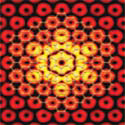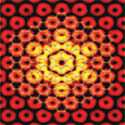Carbon flowers
Although graphene is idealized as a perfect honeycomb lattice, the real material often contains defects that affect its chemical, mechanical, and electronic properties. The same defects could, in principle, be tailor-made to tune these properties for a particular application. There have been numerous studies on the types and effects of point defects (vacancies or impurity atoms) that occur in graphene, but relatively little exploration of more extended topological defects. For example, the threefold carbon bonding in graphene permits defective rings, comprising either five or seven atoms instead of six, to form. These rings can be strung together in extended structures to form linear grain boundaries.
Now, in an article appearing in Physical Review B, Eric Cockayne of the National Institute of Standards and Technology, Gaithersburg, and colleagues have shown that the same five and seven atom rings can be linked together to form closed loops defining an unusual type of grain boundary, and have calculated the energetics of such grain boundary loops. They focus on what they call rotational grain boundaries, which are equivalent to cutting out a portion of the hexagonal lattice and rotating it relative to the pristine lattice. Their calculations enable them to identify among these types of grain boundaries the defect structures with the lowest energies, which include the sixfold “flower” defect. The authors follow up with scanning tunneling microscopy/spectroscopy measurements and indeed observe the flower defect in graphene samples, corroborating the theoretical prediction that this defect should be prevalent due to its low energy. – Alex Klironomos





